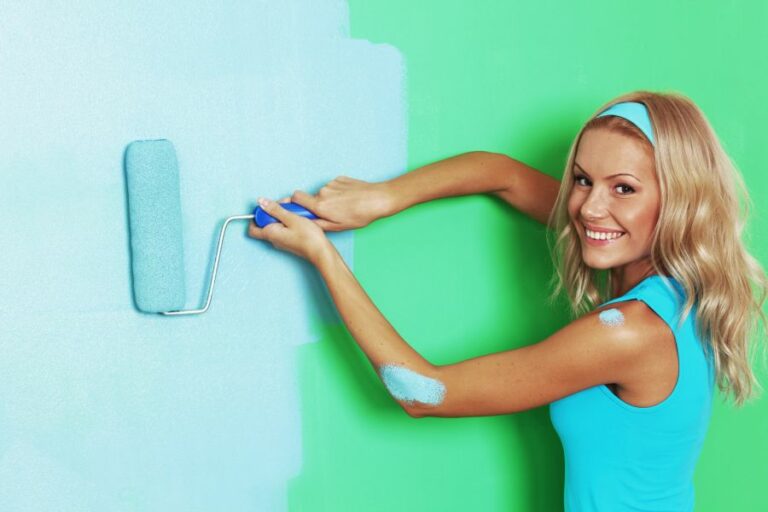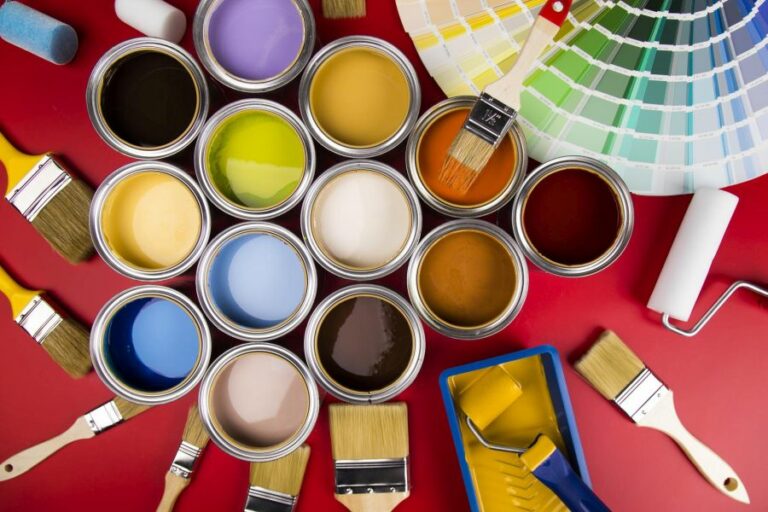Satin Interior Paint Finishes, 25 Things You Should Know
Are you considering a fresh coat of paint to spruce up your living space? Let’s discuss satin interior paint finishes, an option that elegantly combines matte and glossy finishes. With my expertise in paint types and finishes, I can guide you through the benefits of satin paint and help you make the right choice for your home.
Satin interior paint finishes:
Satin interior paint finishes are versatile and elegant for various surfaces, balancing matte and gloss. They are easy to clean, durable, and aesthetically pleasing, perfect for high-traffic areas such as living rooms, bedrooms, and hallways. To achieve the best results, consider surface type, color choice, and paint quality, and apply the paint with proper preparation and technique.

Discover the elegant world of satin interior paint finishes! Dive into the luxurious texture, durability, and application methods of this versatile paint finish, transforming your home interiors into a masterpiece. Don’t wait. Read on to learn how to elevate your living space with satin paint!
Contents
- 1 Satin Finish: An Elegant Choice for Interior Paint
- 2 Exploring the Benefits of Satin Interior Paint Finishes
- 3 Eggshell vs. Satin: Which Wall Finish is Best?
- 4 Ideal Situations for Using Satin Paint in Home Interiors
- 5 Comparing Flat and Satin Finishes for Interior Walls
Satin Finish: An Elegant Choice for Interior Paint
• An Overview Of Satin Paint Finishes
Satin paint finishes offer a soft and elegant sheen, ideal for various interior surfaces. This finish type provides a balance between matte and gloss finishes, offering the best of both worlds.
Easy to clean and durable, satin paint finishes are perfect for high-traffic areas, such as living rooms, bedrooms, and hallways.
• Benefits of Satin Interior Paint Finishes
– Easy to Clean
One of the main benefits of satin paint finishes is their ease of cleaning. Unlike matte finishes, which tend to scuff and show dirt quickly, satin finishes are resistant to minor wear and tear. This makes them an excellent choice for rooms where cleanliness is a priority, such as kitchens and bathrooms.
– Durable and Long-lasting
Satin paint finishes are known for their durability, maintaining their appearance even after years of use. Their natural resistance to moisture, mildew, and stains makes them a popular choice for interior spaces that are prone to humidity, like bathrooms and laundry rooms.
– Aesthetically Pleasing
Satin paint finishes offer a soft, light-reflective surface that can enhance the look of any space. The subtle sheen can provide depth and dimension to walls, helping make a room feel larger and brighter.
• Understanding Satin Paint Sheens
To help choose the right satin paint finish for your project, it’s essential to understand the various sheen levels available. Here’s a quick breakdown of the common satin paint sheens:
– Satin
As the name suggests, satin paint finishes provide a soft, satin-like appearance. This sheen is perfect for creating a sophisticated yet inviting atmosphere in your space.
– Semi-Gloss
A semi-gloss finish offers a slightly higher sheen than a satin finish. It’s often used in kitchens and bathrooms due to its enhanced durability and resistance to moisture and stains.
– Pearl
Falling between satin and semi-gloss sheens, pearl finishes offer a refined and lustrous appearance, making them an excellent choice for elegant and classic spaces.
– Eggshell
Eggshell sheens are very similar to satin but have a slightly lower gloss level. This makes them ideal for areas where you want to achieve a soft, matte appearance without sacrificing durability and ease of cleaning.
• Choosing the Right Satin Paint for Your Project
When selecting a satin paint finish for your interior project, consider the following factors:
– Surface Type
The type of surface you’re planning to paint can impact the performance of your satin paint finish. For example, drywall surfaces tend to absorb paint more than materials like wood or metal. This can lead to uneven coverage and may require additional coats to achieve the desired sheen level.
– Color Choice
Dark colors can highlight imperfections on a wall more than lighter shades. When using a satin paint finish, it’s essential to properly prepare your surface by filling holes, smoothing out rough patches, and adequately priming the surface.
This will ensure an even and smooth finish, regardless of the color chosen.
– Quality of Paint
By choosing high-quality satin paint, you can ensure a better-looking, long-lasting finish. High-quality paints offer better coverage, durability, and color retention, reducing the likelihood of peeling, fading, or chipping over time.
• Expert Tips for Applying Satin Paint
– Proper Preparation
Before applying satin paint, it’s essential to ensure the surface is clean, dry, and free from grease, dust, or debris. Sand down any rough spots and fill any holes or dents with the appropriate filler. Once dry, use a primer designed for your surface type to prepare the wall for painting.
– Use a High-Quality Roller or Brush
Using a high-quality roller or brush is crucial for achieving a smooth and even satin paint finish. Synthetic brushes work best for water-based satin paints, while natural bristle brushes are more suited for oil-based paints.
For roller applications, use a roller cover with a short nap to avoid leaving marks or lint on the painted surface.
– Apply in Thin, Even Coats
Applying satin paint in thin, even coats helps ensure a uniform finish and minimizes the risk of brush marks or roller lines. Allow each coat to dry completely before applying the next, ensuring you follow the manufacturer’s recommended drying times.
• Conclusion
Satin interior paint finishes provide a versatile and attractive option for various interior applications. Offering durability, easy cleaning, and an elegant sheen, satin finishes can enhance any space in your home.
By understanding the various sheen levels, choosing the right paint, and following expert application tips, you can achieve a beautiful satin paint finish in your next interior project.
Exploring the Benefits of Satin Interior Paint Finishes
When deciding on the perfect interior paint finish for your home, it’s essential to consider factors such as durability, ease of cleaning, and room use. Satin finish paint is a popular choice for homeowners due to its attractive appearance and practical features.
• What is Satin Finish Paint?
Satin finish paint is often described as a happy medium between high-gloss and matte paints, creating a subtle sheen that showcases a room’s texture and color. It is less reflective than gloss paint, making it more forgiving when applied to imperfect surfaces.
It’s an ideal paint finish for walls, ceilings, and trims in areas with medium traffic or wear, such as living rooms, bedrooms, and hallways.
• Advantages of Choosing Satin Finish Paint
– Durability and Longevity
One of the key advantages of a satin finish is its durability. Compared to flat or eggshell paints, the satin finish provides a more durable surface that can withstand regular cleaning and resist staining. The paint is less likely to chip or wear over time, which can save you time and money on repainting.
– Ease of Cleaning
Satin finish paint is easier to clean than matte finishes, making it an excellent choice for families with young children or pets. The finish can withstand light scrubbing without losing its sheen, making it ideal for high-touch areas like doors or walls in busy households.
For more information about cleaning and maintaining painted surfaces, the National Center for Healthy Housing provides helpful guidelines.
– Versatility
Satin paint finish can enhance a room’s visual appeal with its subtle shine and rich color. This versatile finish can be applied to any room in the house, offering a wide range of color choices and finishes, making it a suitable pick for any design style or home interior.
• Disadvantages of Satin Finish Paint
Despite its many advantages, there are a few drawbacks to consider when choosing a satin finish paint for your interior space.
– Harder to Touch-Up
Though satin paint is more durable than matte finishes, it can be more challenging to touch up in case of damage or staining. The paint’s subtle sheen may make it difficult to blend repairs seamlessly, especially if the original paint has aged or faded.
– Application Challenges
Satin finish paint may require more skill and attention during application than flat or matte paint. Brush strokes or roller marks can be more visible if care is not taken when applying the paint.
It is important to use high-quality brushes or rollers and follow a consistent painting technique to achieve an even, professional-looking finish.
• Tips for Using Satin Finish Paint
To get the best result when using satin finish paint, follow these expert tips:
- Choose the right primer: To ensure proper adhesion of the paint, start by priming the surface with a high-quality primer. This step is especially crucial for surfaces with imperfections or stains that could show through the paint.
- Apply multiple, thin coats: Satin paint can be prone to drips, runs, or uneven coverage. To prevent these issues, apply thin, even coats of paint, allowing each coat to dry before applying the next one. This method will create a smooth, even finish.
- Use the “W” painting technique: When applying satin paint to walls or ceilings, use a “W” painting technique, starting in one corner and working your way across the surface. This method helps ensure even coverage and prevents visible roller or brush marks.
- Be mindful of lighting: Satin finish paint can appear differently depending on the lighting of your space. Before settling on a color, it’s a good idea to test samples in different lighting conditions to ensure you are happy with the final result.
• Conclusion
Satin finish paint can be a great choice for interior paint due to its durability, ease of cleaning, and versatile appearance. However, some minor drawbacks and application challenges make it essential to carefully consider whether this is the right choice for your project.
By following expert tips and techniques, you can achieve a beautiful satin finish that will enhance your home’s interior for years to come.
Eggshell vs. Satin: Which Wall Finish is Best?
Choosing the right paint finish for your walls is an important step in the painting process. Two popular options are eggshell and satin. Both have their unique benefits, but which one is the better choice for your walls?
• What is Eggshell Paint Finish?
Eggshell paint has a low sheen that resembles the natural finish of an eggshell. This finish, which is slightly more lustrous than a flat finish, is an excellent choice for walls because it is highly durable and relatively easy to clean.
It’s popular among homeowners because it can hide minor imperfections in the wall’s surface while delivering a smooth, elegant look.
• What is Satin Paint Finish?
Satin paint, also known as semi-gloss, has a slightly higher sheen than eggshell. It’s characterized by its soft, velvety appearance and is known for being more durable and easier to clean than eggshell finishes.
The satin finish is often used on walls in high-traffic areas, as well as baseboards, doors, and window trim.
• Key Differences Between Eggshell and Satin Paint Finishes
– Durability and Cleanability
When it comes to durability, satin paint is the clear winner. It is more resilient to wear and tear, making it ideal for high-traffic areas such as hallways, family rooms, and children’s bedrooms.
Additionally, satin paint is easier to clean than eggshell, as it’s more resistant to moisture, dirt, and stains. In contrast, eggshell finishes may require more frequent touch-ups due to their delicate nature.
– Sheen and Appearance
Eggshell and satin finishes differ in the amount of light they reflect. While both finishes offer a soft, elegant appearance, eggshell has a lower sheen, giving it a more subtle and sophisticated look. Satin, on the other hand, has a slightly higher sheen, which can add a touch of glamour and richness to a space.
– Application Difficulties
When it comes to application, eggshell paint is generally easier to apply than satin. Satin paint can be more challenging to work with due to its higher sheen, which can result in streaks or uneven areas if not applied with the proper technique.
Eggshell paint, however, is more forgiving and easier for DIY painters to achieve a smooth, even finish.
– Hiding Imperfections
Eggshell paint is better at hiding imperfections on your walls, as the low sheen helps conceal small dents, scratches, and other blemishes. Satin paint, with its higher sheen, is more likely to highlight any imperfections, making it the better option for surfaces that are smoother and in good condition.
• Recommendations Based on Room Type
– Living Rooms and Bedrooms
For living rooms and bedrooms, I recommend using an eggshell finish. It provides a subtle, elegant look that works well with most design styles while still offering sufficient durability for these spaces.
– Bathrooms and Kitchens
For bathrooms and kitchens, consider using a satin finish due to its higher resistance to moisture and humidity that these areas often experience. The increased durability and cleanability of satin paint make it a suitable choice for these rooms.
– High-Traffic Areas
For hallways and other high-traffic areas, satin paint is the better option, as it offers greater durability and resistance to scuffs, scratches, and stains.
• Environmental Concerns and VOCs
It’s important to note that both eggshell and satin paints are available in low or no-VOC (Volatile Organic Compound) formulations. Visit the United States Environmental Protection Agency website for more information on the impact of VOCs on indoor air quality.
• Conclusion
In deciding between eggshell and satin paint finishes for your walls, factor in the room’s purpose, the condition of the surfaces, and your desired look.
Eggshell is ideal for a subtle, elegant appearance with adequate durability, while satin is better suited to high-traffic areas or rooms with moisture and humidity concerns.
Prioritize low or no-VOC paints for more environmentally friendly options, keeping in mind the different sheen levels and durability of each finish to ensure your walls look beautiful for years to come.
Ideal Situations for Using Satin Paint in Home Interiors
Satin paint, a popular choice for many homeowners, is a versatile paint finish that offers a blend of both matte and glossy qualities.
• Understanding Satin Paint
First, it’s crucial to know what satin paint is and how it differs from other available paint finishes. Satin paint offers a smooth finish with a slight sheen, thus, providing a balance between a matte and glossy look.
Its medium level of reflectivity makes it an excellent choice for various areas in a home or commercial space.
– Advantages of Satin Paint
Now that we have a basic understanding of satin paint, let’s delve into its numerous benefits.
Durability
Satin paint has excellent durability, which makes it suitable for areas exposed to moisture, dirt, and heavy traffic. It can resist stains and withstand regular cleaning without losing its luster and color.
Easy to Clean
Cleaning surfaces painted with satin paint is a breeze. Most spills and stains can be removed with just a damp cloth or sponge without damaging the paint or having to resort to aggressive cleaners.
Aesthetic Appeal
The slight glossiness of satin paint adds depth and richness to the colors, resulting in an aesthetically pleasing appearance. It also helps minimize surface imperfections and gives a luxurious feel to the space.
• Recommended Applications for Satin Paint
Now, let’s explore some of the ideal areas or situations where satin paint shines.
– Kitchens
The kitchen is one of the most suitable places to apply satin paint. With its ability to resist stains, grease, and moisture, it’s perfect for the different surfaces in a kitchen, including walls, cabinets, and baseboards.
– Bathrooms
Satin paint’s resistance to humidity and moisture makes it an excellent choice for bathrooms. By selecting this paint finish, you can easily wipe down any water splashes without compromising the paint’s integrity.
– Hallways and Entryways
High-traffic areas like hallways and entryways are often subject to scuffs, dings, and dirt, making satin paint an ideal choice. The paint’s durability ensures it can withstand frequent cleaning while still retaining its appearance.
– Laundry Rooms and Mudrooms
These functional spaces require paint finishes that can withstand moisture, dirt, and stains. Satin paint’s moisture-resistant qualities make it suitable for laundry rooms and mudrooms.
– Children’s Bedrooms and Playrooms
Satin paint is a great fit for children’s bedrooms and playrooms, thanks to its durability and easy-to-clean nature. The paint’s resistance to stains and damage from crayons or markers makes maintenance much simpler.
• Tips for Applying Satin Paint
To ensure the best results when using satin paint, follow these essential tips:
– Surface Preparation
Properly preparing the surface is crucial for achieving a smooth and long-lasting finish. Make sure to clean the surface thoroughly, removing any dirt, grease, or dust. Fill in any holes or cracks with an appropriate filler, and be sure to sand any rough spots or patched areas.
– Use a High-Quality Primer
To guarantee an even paint application, use a high-quality primer that matches your paint choice. This will create a consistent and uniform base for the satin paint to adhere to, ensuring a professional-looking result.
– Choose the Right Tools
Select a high-quality brush or roller specifically designed for satin paint. This will aid in achieving an even, smooth application and minimize visible brush strokes or roller marks.
– Apply Multiple Coats
To attain the desired coverage and sheen of satin paint, be prepared to apply multiple coats. Allow ample drying time between each coat, as indicated by the manufacturer’s instructions.
– Practice Proper Painting Techniques
Employ the proper painting techniques to eliminate visible brush strokes or roller marks for a smooth finish. For instance, use the “W” technique when rolling and always keep a wet edge to avoid lap marks.
• Conclusion
In conclusion, satin paint is a versatile and practical choice for various spaces in your home or commercial property. Its durability, ease of cleaning, and aesthetic appeal make it a popular option for many applications. Be sure to follow the recommended tips for surface preparation, tools, and painting techniques to achieve the best result when using satin paint.
Comparing Flat and Satin Finishes for Interior Walls
In the world of interior design, there are several factors to consider when choosing the best paint finish for your walls. Two popular options, flat and satin, each offer their own unique characteristics and benefits, making it essential to know the differences and determine which one best suits your needs.
• Characteristics of Flat Paint
Flat paint, also referred to as matte paint, is a non-reflective finish with a velvety texture. Here are some key characteristics of flat paint finishes:
– Excellent Hiding Ability
Flat paint is known for its superior hiding ability, meaning it can effectively mask imperfections on the surface of the wall. This quality makes it an ideal choice for older walls that have cracks or other imperfections, as well as for textured surfaces.
– Easy Touch-ups
Flat paint’s non-reflective finish makes touch-ups less noticeable. If a small area on the wall becomes damaged or dirty, it can be easily repaired with a touch-up coat without the need for repainting the entire wall.
– Minimal Glare
Due to its lack of sheen, flat paint does not cause glare or brightly reflect light. This can be a major advantage in rooms with an abundance of natural light, as it helps to prevent harsh reflections and improve the overall visual comfort of the space.
– Less Adaptable to Cleaning
One downside to flat paint is its susceptibility to dirt and stains. Its porous surface readily absorbs dirt, making it difficult to clean without damaging the paint. This can be an issue in high traffic areas or spaces prone to staining, such as kitchens and children’s rooms.
• Characteristics of Satin Paint
Satin paint, also known as eggshell or low-gloss paint, offers a soft, subtle sheen while still being somewhat reflective. Here are some key characteristics of satin paint finishes:
– Moderate Reflectivity
Unlike flat paint, satin paint has a subtle sheen that reflects light to a certain degree, enhancing the brightness and warmth of a room. This effect can add depth and sophistication to the overall appearance of the space.
– Better Durability
Satin paint is more resistant to scratches, dings, and general wear and tear, making it a better option for high traffic areas and spaces frequently used by children and pets.
– Easier to Clean
The smooth surface of satin paint is more resistant to staining and easier to clean without causing damage to the paint. This is particularly important in areas where cleanliness is essential, such as bathrooms and kitchens.
– Less Effective at Hiding Imperfections
On the downside, satin paint is less proficient at hiding surface imperfections than flat paint due to its sheen. This may require extra preparation or repairs to achieve a smooth finish on the walls before painting.
• Factors to Consider When Choosing Between Flat and Satin Paint
Now that we’ve covered the fundamental attributes of both flat and satin paint finishes, let’s dive into some crucial factors to consider when deciding which option is best for your interior walls:
– Room Function
Consider the primary function of the room when selecting a paint finish. For rooms with a high likelihood of dirt and stains, such as kitchens and bathrooms, satin paint’s easy-to-clean surface is ideal.
In living spaces, bedrooms, and areas where imperfections are a concern, flat paint’s excellent hiding abilities and minimal glare make it a suitable option.
– Traffic Level
Evaluate the amount of traffic the room receives before making your decision. High-traffic areas or spaces frequently used by children and pets, such as hallways and playrooms, will benefit from satin paint’s durability and stain resistance.
In contrast, rooms with less foot traffic or where aesthetic appearance is more important, such as a formal living room, may be better suited for flat paint.
– Wall Condition
Assess the condition of the walls in the room. If there are noticeable imperfections, such as cracks or texturing, flat paint’s superior hiding capabilities will help camouflage these issues. Satin paint, on the other hand, may highlight these imperfections due to its sheen.
– Desired Aesthetic
Finally, consider the desired aesthetic for the room. Flat paint’s matte finish and lack of glare provide a more subdued, elegant look, while satin paint’s subtle sheen can add depth and warmth, giving the room a more polished appearance.
• Conclusion
In conclusion, both flat and satin paint finishes offer distinctive qualities and advantages, making them suitable for different applications depending on the specific requirements of the space.
By considering the room’s function, traffic level, wall condition, and desired aesthetic, you can make an informed decision on whether flat or satin paint is the ideal finish for your interior walls.
For additional guidance on choosing the best paint finish for your project, consult resources such as Benjamin Moore’s paint selection guide or consult with a local painting professional.







